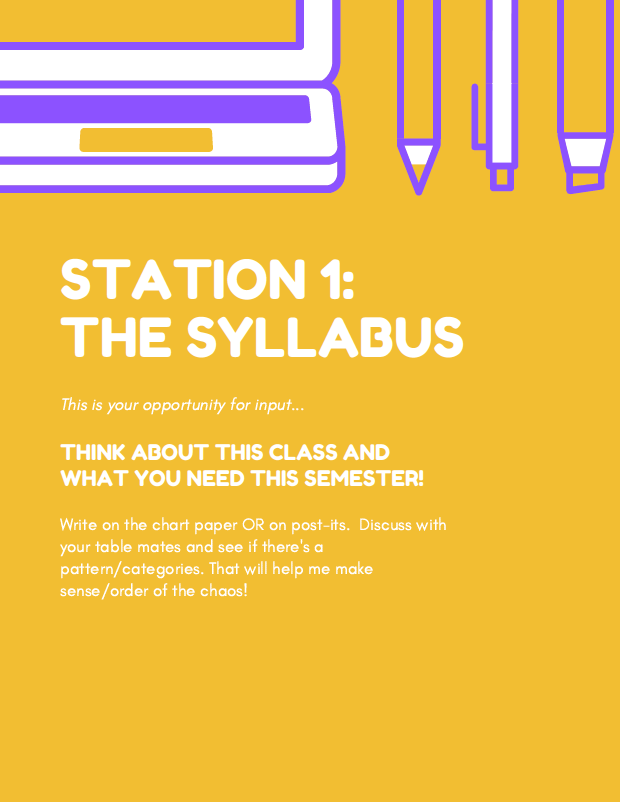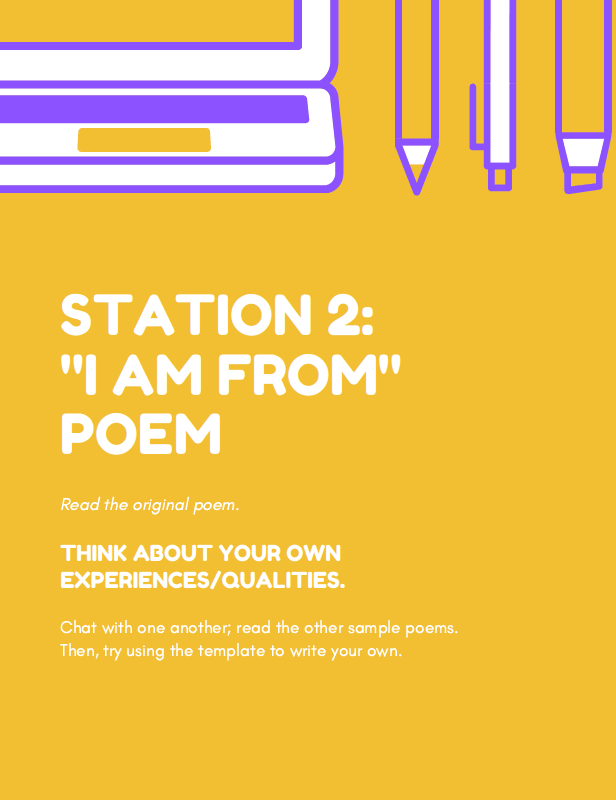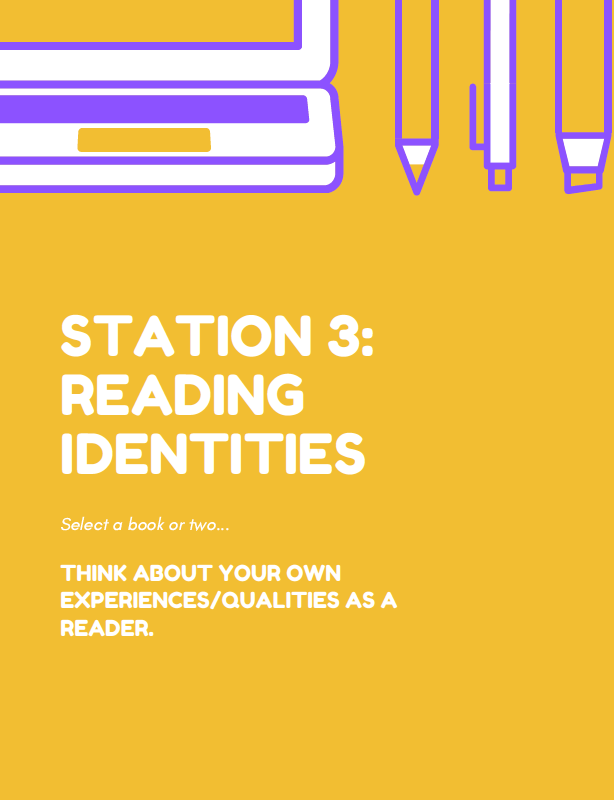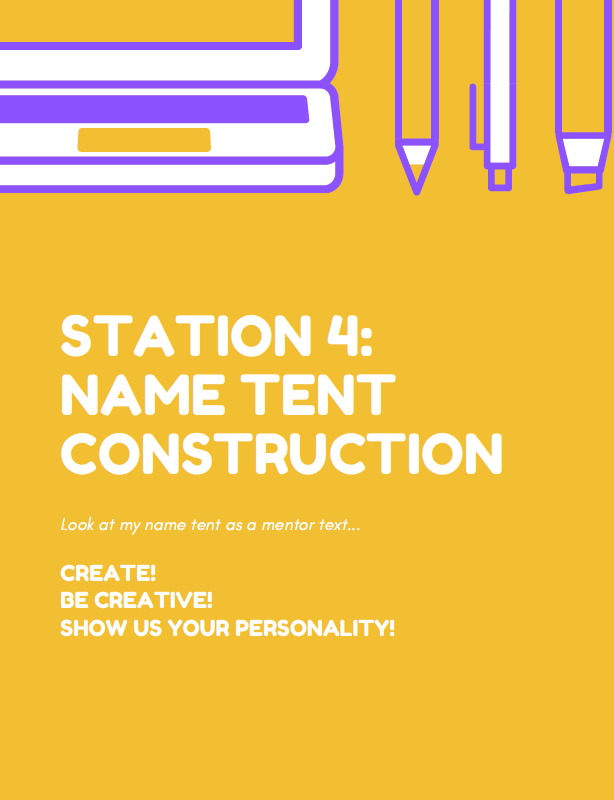September Snapshot: Learning Stations for Everyone!
After a robust & interactive summer experience at the writing project, I knew I didn’t want to start day one of the fall semester with a typical ‘read the syllabus day’; I just didn’t know what I actually wanted to do. After reading an article on edutopia about Learning Stations, I thought that the strategies presented could work at the university level. I let the ideas marinate in my mind for a few days and decided that I would give it a try.
As a teacher educator, I try to model best practices whenever possible so my students can experience activities and lessons as learners first, then reflect on their own (future) practice. To be honest, I wasn’t exactly sure what would happen, but I thought even modeling that vulnerability for my students would prove to be a good thing.
I started with making the ‘Station Markers’ on Canva and have linked a copy of them here. Once I settled on the template, and made the first one, it was easy to copy and edit the following. After that, I just needed to gather supplies and come up with a strategy to get everything to the classroom. (This is probably just an issue for us in higher ed or for teachers who have to share classrooms. You will most likely just set up your room for the stations and not have to transport everything.)
Going back to the original article, here’s how I modified her suggestions for my ENG 390: Teaching English in the Secondary Schools course:
Station 1: The Syllabus

This particular class is one of the final methods courses that students take before student teaching; I intentionally left space at this station for students to reflect on what they already know and what they want to learn this semester to best prepare themselves for student teaching. There was an excellent discussion that ranged from theoretical to practical components of the course. After the class was over, I categorized the post it notes into the following categories: Choice, Motivation, and Innovation. Those seemed like fantastic categories to use when framing the course.
I was really proud of my students for being so transparent on the first day of class; to be fair, most of these students already know me from previous courses or their involvement with the NCTE Student Affiliate on campus. This might be why they felt comfortable jumping right into activities like this. Other students might need more community and trust building before being asked such questions.
Station 2: : Poetry Station

Even though these students know one another, I wanted to include some sort of writing that would help them learn even more about one another. I thought a short piece would work for this type of classroom set up. I started with the original “Where I’m From” poem by George Ella Lyons and included a template for the students to use to write their own poems, along with some examples of other student work. Most students used their time at this station to chat and brainstorm then jump into writing. I thought they’d need more time to polish these, so they were actually due at the next class meeting.
Station 3: Reading Identities

This station had two parts really. Thanks to the generosity of Scholastic I had a box of newly released books for middle and high school classrooms. Students were to ‘judge a book by its cover’ and select one to read this semester FOR FUN. I was very clear that this was not an additional assignment, that they need to hold themselves accountable as readers.

Once they selected the text, I asked them to snap the QR code on the chart and share a little about themselves as readers. Those responses can be seen here on Flipgrid. I think this activity was important for several reasons – one, teachers of English need to see themselves as readers if they hope to inspire young people to be/become lifelong readers. Two, by sharing their response on Flipgrid, they could see how diverse the readers in our class were…again, thinking ahead to future classrooms with a wide variety of interests to manage. Three, I also shared my current reading with them to show that I, too, am a reader.
Station 4: Name Tent Construction

While this is pretty standard practice, I take it just a bit further…I ask them to not only write their names, but to identify other factors as well.
- Hometown
- Book you wish you wrote
- Guilty pleasure
- Favorite food.
If I’m not mistaken, I got this idea from Brenda Krupp and Mary Buckelew, when I took the PAWLP Summer Institute.
I leave my own name tent out so they can see it as a mentor text; we brainstorm what else you might ask students to reveal a little of their personality at the beginning of class. Since there are only a few students at the station, it’s easier to share that – perhaps – than it would be if you had to share with the whole class.
What I learned…
Students can surprise you with how open they are to new things. I mentioned that most of these students already knew me, but some didn’t. And, none of my WRT120 students knew me, but they did a modified version of this too and none of them dropped the course!
Their reflective feedback also informed my practice. Some students, even in teacher preparation programs, are introverted. The usual ‘go-around-the-room-and-introduce-yourself-to-the-whole-class’ activity can be utterly terrifying for some folks. This approach allowed them the intimacy of small spaces and then we could grow our community over the first few weeks of class. And through a variety of other activities, we did that.
I also learned that this type of activity really set the expectations for the course. We are all in this together. We are all here to learn and experiment. I shared that this was the first time I was trying it…I think they appreciated that vulnerability from a veteran educator and were willing to share constructive feedback that I will definitely implement next time!




